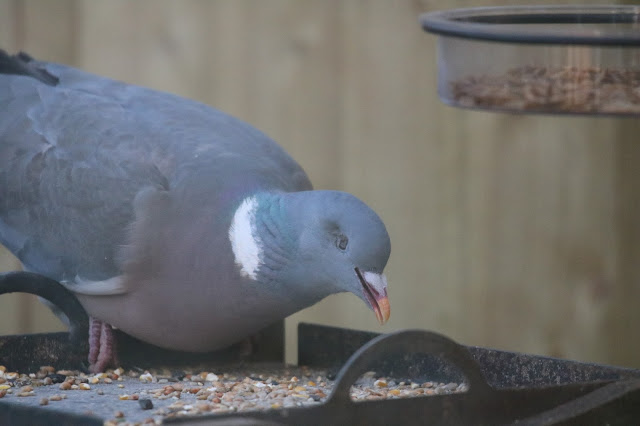First of all, I apologise for not posting for awhile but a touch of the flu laid me out for 2 weeks. I am all better now and this weekend I have been out and about, checking my trail cam, counting swans and watching the birds in the garden.
We have a new feeding station which contains mealworms, suet pieces and white sunflower seeds and this afternoon I watched the birds adjust to this new item in the garden in the sunshine. The first to approach was a Starling followed shortly by a Robin which has started to exhibit mating signs and nesting behaviour.
Most interestingly a single Blue Tit came to feed exclusively on the dried mealworms. This individual had a dishevelled look and a deformed beak - see below.
Such deformities are not uncommon in Blue Tits. In this case, the beak is longer than normal with a hyperextended upper mandible.
Such deformities are found in many Tit species and the BTO Garden Watch has documented the rise of this possible disease.
 |
| Data from British Trust for Ornithology - https://www.bto.org/volunteer-surveys/gbw/about/background/projects/bgbw/results/types |
Such deformities in the beak are not fully understood and is named as Avian Keratin Disorder (AKD). This relates to the fabric of the beak itself which is a keratin sheath over bone. It has been suggested that because keratin continues to grow like our fingernails that the defect is due to the beak not getting worn down but this does not explain many of the cases.
If the beak deformity is too extreme then it will have a negative effect on the ability for the bird to feed itself and die fairly quickly. In this case, the beak has not hindered the birds feeding although it is possible that such birds only survive at feeders and would struggle foraging for itself. It would be interesting to see if the deformities occur in wild populations. Are they an example of over-identification in well-watched gardens or is their survival greater in gardens.
Whilst the causes are not fully understood some research has been taken in America. AKD was first recorded in Alaska in Chickadees (North American relatives of the Tits) in the 1990's and was subsequently recorded in Nuthatches and Crows. USGS scientist Dr Colleen Handel began investigating the occurrence and originally started looking at organochlorine poisoning and strontium depletion before coming across the possibility of a pathogenic cause.
 |
| Blacked-Capped Chickadee. Photograph by: Alan D. Wilson, www.naturespicsonline.com |
Her studies involved genetic level studies of the birds and revealed an RNA virus in the Picornnavirus family that she named Poecivrius. This virus was found in 100% of birds studied with the deformities and only 22% of those without it. The paper was published in 2016.
It is likely that the real cause is more complicated than just a virus and although promising this was a small study which so far has not been followed up and there appears to have been no work to identify the virus in British populations.
You can report any sightings of birds with deformed beaks to the BTO - https://www.surveymonkey.com/r/MF9PHYJ?sm=8eLw8z78HLBP8EQrk4oCQA%3d%3d
Whilst the Blue Tit continued to feed a Woodpigeon tentatively approached the bird feeder. He seemed less skittish as usual and his behaviour was slightly off and it soon became apparent. He was blind in the right eye, in fact, he had no right eye at all. It's hard to tell from the picture if this was a result of injury or a birth defect.
The bird seemed well fed and otherwise unaffected, such a disability is rarely seen it usually increases their chance of predation that they do not last long. However, by looking around more and shifting his head the pigeon seems to be doing fine although the loss of depth perception gained from two eyes meant his landing was a little clumsy.
References:
Zylberberg M, Van Hemert C, Dumbacher JP, Handel CM, Tihan T, DeRisi JL. Novel Picornavirus Associated with Avian Keratin Disorder in Alaskan Birds. mBio. 2016;7(4):e00874-16. doi:10.1128/mBio.00874-16.
References:
Zylberberg M, Van Hemert C, Dumbacher JP, Handel CM, Tihan T, DeRisi JL. Novel Picornavirus Associated with Avian Keratin Disorder in Alaskan Birds. mBio. 2016;7(4):e00874-16. doi:10.1128/mBio.00874-16.


No comments:
Post a Comment